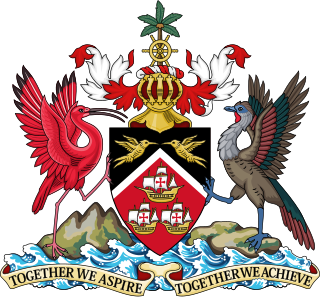
Caroni County was a historic county of Trinidad and Tobago. It occupies 557 km2 (215 sq mi) in the west central part of the island of Trinidad, the larger island in the Republic of Trinidad and Tobago. It lies south and southwest of Saint George County, west of Nariva County and north of Victoria County. To the west it is bounded by the Gulf of Paria. County Caroni includes the towns of Chaguanas, the largest town in the country and Couva, the capital of the Couva–Tabaquite–Talparo region. Administratively it is divided between the Borough of Chaguanas, the Region of Couva–Tabaquite–Talparo and the Region of Tunapuna–Piarco. The county was divided into four Wards: Chaguanas, Couva, Cunupia and Montserrat. The major towns of County Caroni are Chaguanas and Couva. The port and industrial zone of Point Lisas is located in Caroni, and the region is also a site for agriculture.
Couva is an urban town in west-central Trinidad, south of Port of Spain and Chaguanas and north of San Fernando and Point Fortin. It is the capital and main urban centre of Couva–Tabaquite–Talparo, and the Greater Couva area includes the Point Lisas industrial estate and the port of Point Lisas. It is one of the fastest-growing towns in the country. Couva's southern boundary is at the village of California and Point Lisas, and to the north Couva stretches to McBean. To the east of Couva is Preysal. To the west of Couva is the road to Waterloo and Carli Bay, which are located on the Gulf of Paria. Couva was part of the Caroni County. Couva is considered a major power base for the United National Congress, whose headquarters was previously located here.

Hinduism in Trinidad and Tobago is the second largest religion. Hindu culture arrived to Trinidad and Tobago in 1845, with the arrival of the first Indian indentured laborers, whom an overwhelming majority of were Hindu. According to the 2011 census there were 240,100 declared Hindus in Trinidad and Tobago.

The counties of Trinidad and Tobago are historic administrative divisions of Trinidad and Tobago. Trinidad was divided into eight counties, and these counties were subdivided into wards. Tobago was administered as a ward of Saint David County.

The Trinidad and Tobago Amateur Radio Society, Inc. (TTARS) is the national amateur radio organization in the Republic of Trinidad and Tobago. It is a member society of the International Amateur Radio Union (IARU).

Couva–Tabaquite–Talparo is one of the nine regions of Trinidad and Tobago, and one of the five regions which form the Gulf of Paria coastline on Trinidad's West Coast. Its regional capital and commercial center is Couva. Couva–Tabaquite–Talparo is the third-largest of Trinidad and Tobago's nine regions, with an area of 723 square kilometres (300 sq mi). As of 2011, the population was 178,410. The region is the second-most populous and fourth-least-densely populated region in Trinidad with 247 inhabitants per square kilometre (640/sq mi).

Tunapuna–Piarco is one of the 9 regions of Trinidad and Tobago. It is the most populous region in the country by total population and the fifth-largest by total land area. Geographically located in Northern Trinidad, Tunapuna–Piarco shares its borders with the regions of San Juan–Laventille to the west, Couva–Tabaquite–Talparo to the south, the Borough of Chaguanas to the south-west, Sangre Grande to the east and the Caribbean Sea to the north. The region also completely surrounds the Royal Chartered Borough of Arima, which is located in the south-eastern corner of the region.

Maxi taxis are private, owner-operated minibuses in Romania and Trinidad and Tobago that are used in public transport. They operate along fixed routes, having fixed fares and meeting points, but do not operate under a timetable.
General elections were held in Trinidad and Tobago on 5 November 2007. Nomination day was 15 October. Five parties contested the elections; the ruling People's National Movement, the official opposition United National Congress–Alliance, the Congress of the People, the Tobago United Front–Democratic Action Congress and the Democratic National Assembly. Five independent candidates also ran.
The Trinidad Rapid Railway is a proposed passenger railway system in Trinidad and Tobago.

At the ceremonial opening of the Tenth Republican Parliament on June 18, 2010, the Prime Minister Kamla Persad-Bissessar announced that the date for the 2010 Local Elections was to be on July 26, 2010.

The 2003 Trinidadian local elections were held for the regions and municipalities of Trinidad and Tobago. These municipalities and regions were created after the amendment of Act No.8 of 1992.

The 2023 Trinidadian local elections were held on Monday, August 14, 2023, across all 141 electoral districts in Trinidad's 14 municipal corporation electoral areas. The elections follow a 3-2 ruling on May 18, 2023, from the United Kingdom's Judicial Committee of the Privy Council, the Republic of Trinidad and Tobago's highest court of appeal, which stated that the government's one-year extension of the mandate of councillors and alderman was unlawful. The matter was brought before the Law Lords of the Privy Council by Ravi Balgobin Maharaj, and his legal team led by Anand Ramlogan, SC. The legal action taken by Ravi Balgobin Maharaj was necessary after the PNM government decided to extend the election by one year, which the Privy Council ruled was inconsistent with the rule of Democracy. The judgment handed down to Ravi Balgobin Maharaj by the Law Lords was a landmark ruling in the Commonwealth and marks the first time that a Court upheld the rights of citizens to vote in a Local Government Election.










